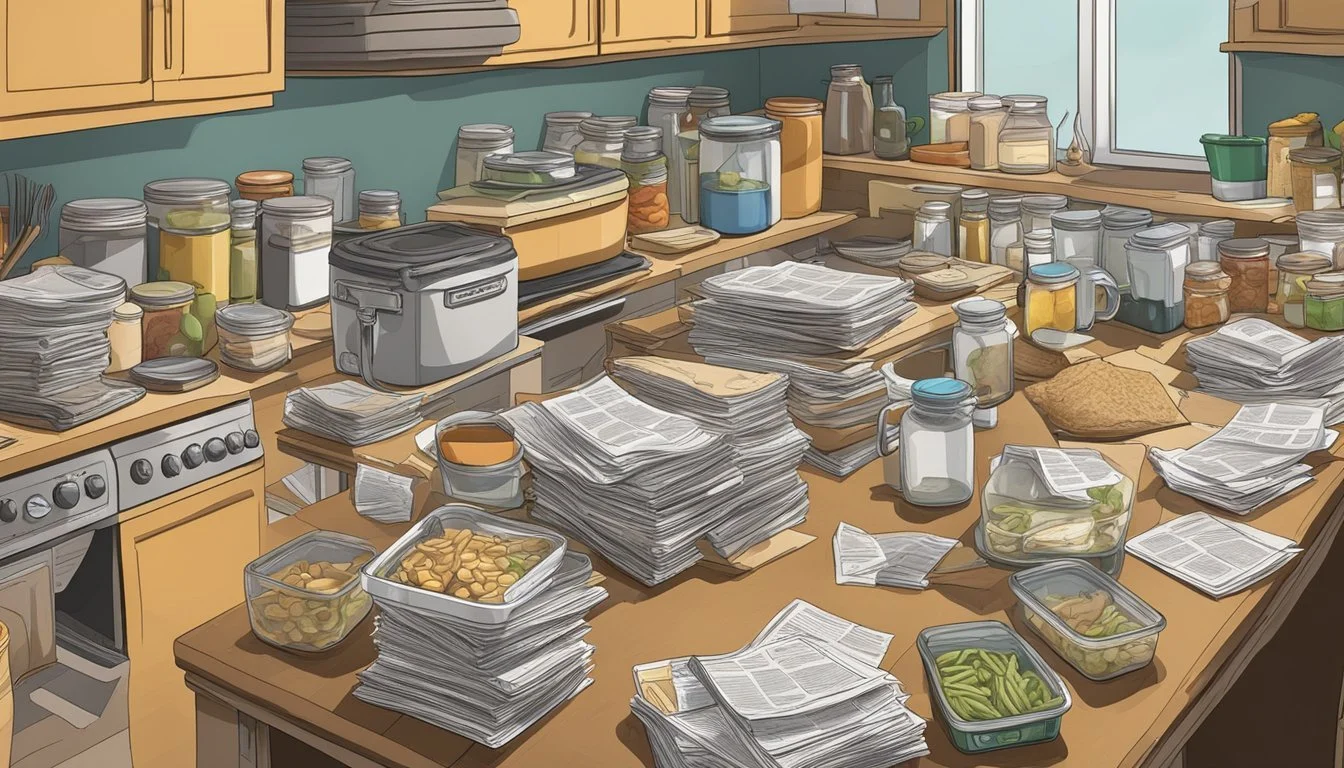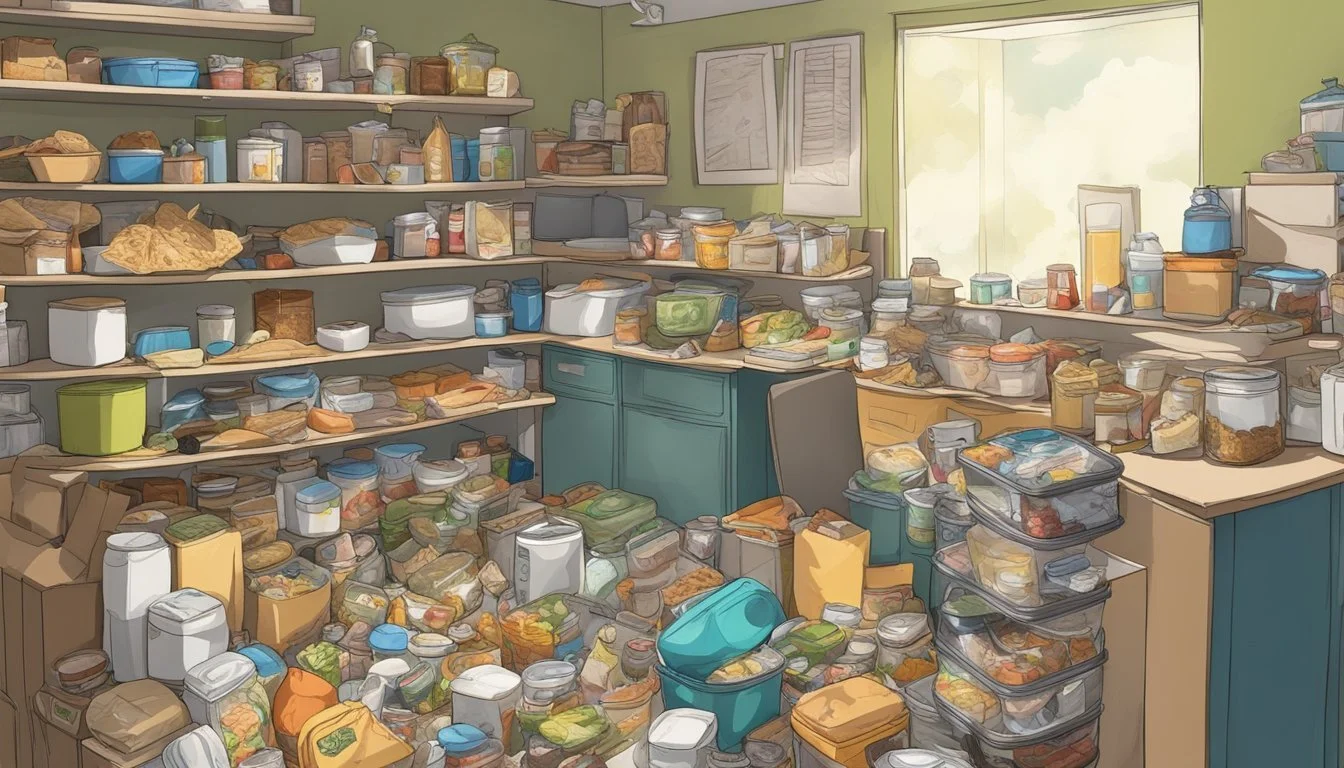Understanding the Link Between Hoarding and Eating Disorders
Hoarding eating disorder is a complex condition that combines aspects of hoarding behavior with disordered eating patterns. Individuals affected may accumulate large amounts of food and experience intense distress at the thought of discarding it, even when it's no longer safe to consume. This behavior can lead to serious health consequences and impact a person's quality of life.
Food hoarding often stems from underlying psychological issues rather than a simple desire to stockpile groceries. It may be linked to anxiety, obsessive-compulsive tendencies, or past experiences of food insecurity. People who hoard food might also engage in other disordered eating behaviors, such as binge eating or restrictive dieting.
Recognizing the signs of food hoarding is crucial for early intervention and treatment. These may include hiding food, buying excessive amounts of perishables, or experiencing shame and secrecy around food-related behaviors. Seeking help from healthcare professionals can provide individuals with the support and strategies needed to address both the hoarding compulsions and any associated eating disorders.
Understanding Hoarding Eating Disorder
Hoarding eating disorder is a complex mental health condition characterized by excessive food acquisition and storage. It often involves anxiety, compulsive behaviors, and difficulty discarding food items.
Definition and Overview
Hoarding eating disorder combines elements of hoarding disorder and disordered eating patterns. Individuals with this condition accumulate large quantities of food beyond what is necessary for normal consumption. They may purchase excessive amounts of groceries or save leftover food items indefinitely.
This behavior is often driven by intense anxiety about potential food scarcity or waste. People with hoarding eating disorder typically experience strong emotional attachments to food and struggle to discard even spoiled or expired items.
The disorder can severely impact daily functioning, relationships, and living conditions. Kitchens and food storage areas may become cluttered and unsanitary due to the buildup of hoarded food items.
Symptoms and Diagnosis
Key symptoms of hoarding eating disorder include:
Excessive food purchases
Difficulty discarding expired or spoiled food
Extreme distress when attempting to throw away food
Cluttered living spaces due to food accumulation
Anxiety about running out of food
Social isolation to hide hoarding behaviors
Diagnosis involves assessing the severity of hoarding behaviors, their impact on daily life, and any co-occurring mental health conditions. A mental health professional may use clinical interviews and standardized assessment tools to evaluate symptoms.
Hoarding eating disorder often overlaps with other conditions like obsessive-compulsive disorder, depression, or generalized anxiety disorder. Proper diagnosis is crucial for developing an effective treatment plan tailored to the individual's specific needs.
Psychological Factors
Hoarding behaviors often stem from complex psychological factors that intertwine with emotions, past experiences, and mental health conditions. These underlying issues can significantly influence the development and persistence of hoarding tendencies.
Anxiety and Stress
Anxiety plays a crucial role in hoarding behaviors. Individuals may accumulate items as a way to feel safe and secure. This behavior can act as a coping mechanism for stress and uncertainty.
Excessive worry about potential future needs often drives the acquisition of unnecessary items. The act of collecting may temporarily alleviate anxiety, creating a cycle of hoarding behavior.
Stressful life events can trigger or exacerbate hoarding tendencies. Major life changes, such as job loss or divorce, may intensify the need for control through possession accumulation.
Depression and Emotional State
Depression frequently co-occurs with hoarding disorder. Individuals may use possessions to fill emotional voids or combat feelings of emptiness.
Low mood and lack of motivation can hinder decluttering efforts. The energy required to sort through items becomes overwhelming, leading to further accumulation.
Emotional attachment to objects often intensifies in depressed states. Items may represent happier times or serve as reminders of lost loved ones, making it difficult to discard them.
Trauma and Coping Mechanisms
Past traumatic experiences can significantly impact hoarding behaviors. Childhood neglect or abuse may lead to an overcompensation through excessive acquisition in adulthood.
Hoarding can serve as a maladaptive coping mechanism for unresolved trauma. The accumulation of items may provide a sense of comfort or act as a barrier against painful memories.
Food-related trauma can contribute to specific hoarding patterns involving food items. Individuals who experienced food insecurity may stockpile edibles beyond reasonable needs.
Addressing underlying psychological factors is crucial for effective treatment of hoarding behaviors. Therapy can help individuals develop healthier coping strategies and emotional regulation skills.
Behavioral Patterns
Hoarding eating disorders involve distinct behavioral patterns centered around food acquisition and storage. These patterns often intersect with obsessive-compulsive tendencies and can be triggered by various life circumstances.
Compulsive Collecting
Individuals with hoarding eating disorders often engage in excessive food acquisition. They may purchase large quantities of food items, far beyond what is necessary for typical consumption. This behavior can lead to stockpiling of non-perishables and frozen goods.
Compulsive collectors might frequent multiple grocery stores in a single day. They may feel anxious or incomplete if unable to acquire specific items. Some hoarders collect food items they don't intend to eat, driven by a perceived need for abundance.
The collecting behavior often results in cluttered living spaces. Kitchens, pantries, and even bedrooms may become overwhelmed with food items. This clutter can interfere with daily functioning and hygiene.
Food Hoarding Specifics
Food hoarding manifests in specific ways. Hoarders may have difficulty discarding expired or spoiled food items. They might keep rotting produce or moldy bread, unable to part with these items despite health risks.
Some individuals engage in secretive eating habits. They may hide food in unusual places throughout their living space. This can include stashing snacks in clothing drawers or under furniture.
Food rituals are common among hoarders. These might involve precise arrangements of food items or specific eating patterns. For example, a person might insist on having exactly three types of cereal available at all times.
Triggering Life Events
Hoarding behaviors often intensify following stressful life events. Trauma, such as the loss of a loved one or financial hardship, can exacerbate food hoarding tendencies. These events may trigger fears of scarcity or lack of control.
Relationship difficulties can also play a role. Divorce, breakups, or family conflicts might lead to increased hoarding as a coping mechanism. The act of collecting food may provide a sense of comfort or stability.
Major life transitions, like moving to a new city or changing jobs, can trigger hoarding behaviors. These changes may create feelings of uncertainty, leading individuals to seek control through food accumulation.
Sociocultural Influences
Sociocultural factors significantly impact hoarding eating disorder. These influences shape individuals' behaviors, beliefs, and relationships around food and possessions.
Relationships and Social Isolation
Hoarding eating disorder often leads to strained relationships and social withdrawal. Individuals may feel shame about their living conditions or eating habits, causing them to avoid social interactions. This isolation can reinforce hoarding behaviors and disordered eating patterns.
Fear of judgment from others may prevent sufferers from seeking help or allowing people into their homes. Relationship difficulties can arise as family members and friends struggle to understand and cope with the disorder.
Some individuals with hoarding eating disorder may use food or possessions as a substitute for human connection. They might develop strong emotional attachments to objects or food, viewing them as sources of comfort and security.
Media and Societal Expectations
Media portrayals and societal norms can exacerbate hoarding eating disorder. TV shows often sensationalize hoarding, potentially increasing shame and stigma for those affected. This negative representation may discourage individuals from acknowledging their struggles or seeking treatment.
Societal pressure to maintain a certain appearance or lifestyle can contribute to disordered eating and hoarding behaviors. Unrealistic beauty standards may fuel food hoarding or restrictive eating habits.
Advertising and consumer culture can intensify the urge to acquire and keep possessions. This constant exposure to consumption messages may reinforce beliefs about the value and necessity of accumulating items.
Social media can also play a role, with carefully curated images of "perfect" homes and bodies potentially triggering feelings of inadequacy and fueling compensatory behaviors.
Types of Eating Disorders and Hoarding
Eating disorders often involve complex relationships with food that can manifest in hoarding-like behaviors. These conditions frequently intersect with compulsive tendencies and mental health challenges.
Anorexia Nervosa and Hoarding
Anorexia nervosa is characterized by severe food restriction and an intense fear of weight gain. Some individuals with anorexia may engage in food hoarding behaviors despite their restrictive eating patterns.
They might collect and store food without consuming it, creating a sense of control over their environment. This paradoxical behavior can stem from a preoccupation with food due to self-imposed starvation.
Food hoarding in anorexia often coexists with obsessive-compulsive traits. The act of accumulating food may provide a false sense of security while maintaining strict dietary rules.
Bulimia Nervosa and Collecting
Bulimia nervosa involves cycles of binge eating followed by compensatory behaviors like purging. People with bulimia may collect or hoard food in preparation for binge episodes.
This collecting behavior can be driven by a fear of food scarcity or a need to have specific binge foods readily available. Secret stashes of food are common, as individuals attempt to hide their disorder from others.
Bulimia and food hoarding can both stem from a lack of control over eating habits. The accumulation of food may temporarily alleviate anxiety about future binges.
Binge Eating Disorder and Accumulation
Binge Eating Disorder (BED) is marked by recurrent episodes of consuming large quantities of food in a short time. Individuals with BED may stockpile food to ensure a constant supply for binges.
This accumulation can lead to overflowing pantries and hidden food caches. The behavior is often fueled by a persistent fear of not having enough food available when the urge to binge strikes.
Food hoarding in BED can exacerbate the disorder by providing easy access to large amounts of food. It may also increase feelings of shame and reinforce the cycle of binge eating.
Impacts and Consequences
Hoarding eating disorder has far-reaching effects on an individual's wellbeing, relationships, and daily functioning. The consequences extend beyond physical health to impact mental state, social connections, and financial stability.
Health Implications
Hoarding eating disorder can lead to severe nutritional deficiencies and metabolic imbalances. Excessive food consumption may result in obesity, diabetes, and cardiovascular problems. Conversely, periods of restriction can cause malnutrition and weakened immune function.
Digestive issues often arise, including acid reflux, constipation, and stomach pain. The disorder strains the body's organs, potentially leading to liver and kidney damage over time.
Mental health is significantly affected. Anxiety and depression frequently co-occur with hoarding eating behaviors. Obsessive thoughts about food and compulsive eating patterns can dominate a person's mental landscape, leading to chronic stress and emotional instability.
Quality of Life
The disorder severely impacts daily living and personal relationships. Individuals may experience intense shame and guilt, leading to social isolation and withdrawal from activities they once enjoyed.
Time and energy become consumed by food-related thoughts and behaviors, leaving little room for other pursuits or interests. This can hinder career advancement and personal growth.
Relationships often suffer as the individual struggles to engage in normal social activities involving food. Family members and friends may feel frustrated or helpless, straining important support systems.
Sleep disturbances are common, further affecting mood and cognitive function. The constant preoccupation with food can lead to difficulty concentrating and reduced productivity in work or school settings.
Financial and Social Costs
Hoarding eating disorder can impose significant financial burdens. Excessive food purchases strain budgets, while potential health complications lead to increased medical expenses.
Employment may be affected due to decreased productivity or absences related to the disorder. In severe cases, individuals might struggle to maintain steady employment.
The social costs are equally substantial. Stigma surrounding eating disorders can lead to discrimination and misunderstanding. This may result in lost opportunities for career advancement or forming new relationships.
Resources for treatment and support can be limited or expensive, creating additional financial stress. The time and energy required for recovery can also impact work and personal commitments.
Treatment and Recovery
Effective treatment for hoarding eating disorder involves professional help, support systems, and self-help strategies. These approaches work together to address the complex nature of the disorder and promote lasting recovery.
Professional Help and Therapy
Cognitive Behavioral Therapy (CBT) is a primary treatment for hoarding eating disorder. It helps individuals challenge thoughts and behaviors related to food hoarding. A specialized form called Enhanced CBT (CBT-e) focuses on eating disorder-specific issues.
Therapists may also address underlying mood disorders or traumas contributing to hoarding behaviors. Medication might be prescribed to manage anxiety or depression often associated with the condition.
Treatment plans are typically individualized, considering both physical and emotional aspects of the disorder. Eating disorder specialists play a crucial role in developing comprehensive strategies for recovery.
Support Systems and Resources
Support groups provide valuable peer connections for individuals struggling with hoarding eating disorder. These groups offer a safe space to share experiences and coping strategies.
Online resources and educational materials can help patients and families better understand the disorder. Many organizations provide helplines and information on treatment options.
Community-based programs may offer assistance with decluttering and organizing living spaces. Family therapy can be beneficial, helping loved ones understand and support the recovery process.
Self-Help Strategies
Developing healthy eating habits is crucial for recovery. This includes establishing regular meal times and practicing mindful eating techniques.
Creating a structured environment can help reduce hoarding tendencies. Implementing organization systems and setting limits on food purchases are effective strategies.
Stress-reduction techniques like meditation or yoga can help manage anxiety related to food hoarding. Engaging in enjoyable activities and hobbies provides positive distractions and promotes overall well-being.
Journaling about food-related thoughts and behaviors can increase self-awareness. Gradually practicing sorting and discarding excess food items helps build confidence in managing possessions.
Prevention and Awareness
Education and public outreach play crucial roles in preventing hoarding eating disorders. Early intervention strategies can significantly reduce risks and improve outcomes for individuals at risk.
Education and Public Outreach
Schools implement comprehensive programs to educate students about healthy eating habits and body image. These initiatives often include media literacy training to help young people critically analyze unrealistic beauty standards. Community awareness campaigns utilize social media, local events, and informational materials to spread knowledge about hoarding eating disorders.
Healthcare providers receive specialized training to recognize early warning signs. They incorporate screening tools into routine checkups to identify at-risk individuals. Public health departments organize workshops and seminars for parents, teachers, and community leaders to increase understanding of these disorders.
Early Intervention Strategies
Mental health professionals develop targeted interventions for individuals showing early signs of hoarding eating behaviors. These programs often focus on stress management techniques, anxiety reduction, and developing healthy relationships with food.
Support groups provide safe spaces for individuals to share experiences and coping strategies. Family-based therapies involve parents and siblings in the recovery process, addressing underlying family dynamics that may contribute to disordered eating patterns.
Online resources and helplines offer confidential support and guidance. Cognitive-behavioral therapy and mindfulness-based approaches help individuals challenge distorted thought patterns related to food and body image.





